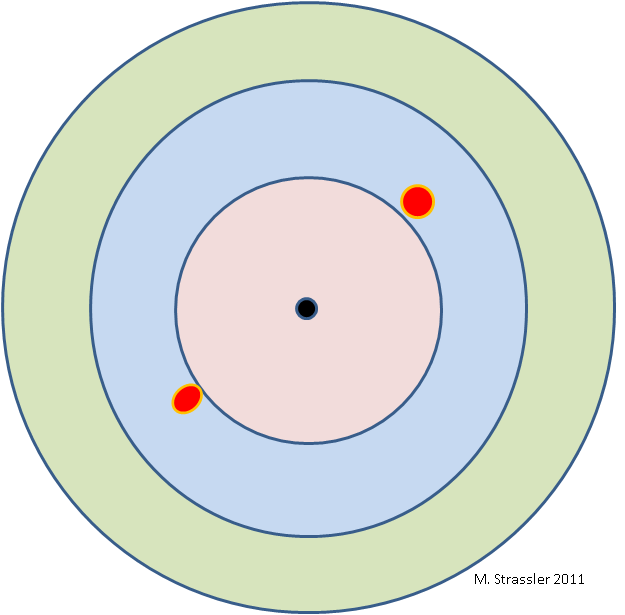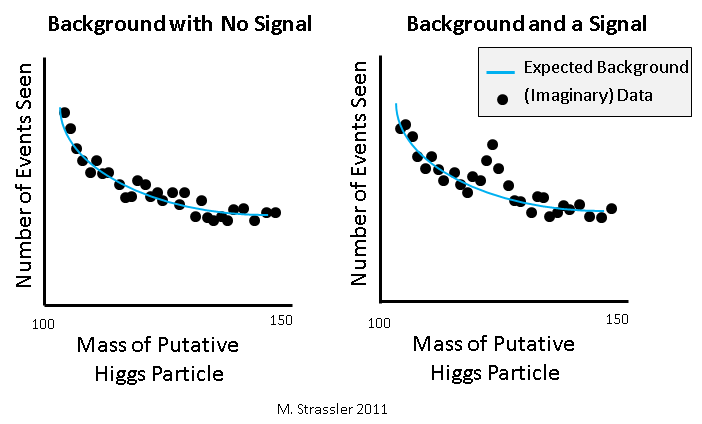Matt Strassler 12/5/11
The reason it is hard to find a lightweight Standard Model Higgs particle (lightweight: with mass-energy [E=mc2] between 115 and 130 GeV; Standard Model Higgs: the simplest possible form of the Higgs particle) is (1) that (like most particles) it decays long before we have a chance to observe it directly, and (2) that what it decays to isn’t usually very distinctive.
In what follows, I’m going to explain
- why most of the any lightweight Standard Model Higgs particles made at the LHC can’t be identified as such.
- why, although a lightweight Higgs particle decays to two photons very rarely, this decay mode can (with enough data) be used to discover the Higgs particle, and how this is done.
Why most lightweight Standard Model Higgs particle decays are useless
Such a Higgs particle decays almost 80% of the time to a bottom quark and a bottom anti-quark, making two jets. Although bottom quark (or anti-quark) jets are somewhat distinctive, ordinary LHC collisions produce a bottom quark and a bottom antiquark over a million times more often than they produce a Higgs particle. So trying to find a Higgs particle that decays this way is much like trying to find a star in daylight. The light from the star is drowned out by the ordinary light from the sun; analogously, the signal of the Higgs particle is completely drowned out by the background from the ordinary LHC collisions. You’ll never find it this way.
A few percent of the time, such a Higgs particle decays to a pair of gluons, or to a charm quark and a charm anti-quark, making two jets. These jets are less distinctive than those from bottom quarks, and the backgrounds from ordinary LHC collisions are even worse. So these decays are useless too.
Just under 10% of the time, such a Higgs decays to a tau lepton and a tau anti-lepton. But the tau lepton and anti-lepton both decay rather quickly to other particles (an electron, a muon or a couple of hadrons [hadron: particle made from quarks, antiquarks and gluons]), along with one or two neutrinos. Since neutrinos pass right through the LHC detectors without leaving any imprint, it is never possible to infer what the energy and momentum of the tau were, and therefore it is difficult to infer whether they might have come from a new massive particle, such as a Higgs particle. On top of this, a tau lepton and tau anti-lepton are a thousand times more likely to have come from a decaying Z particle than from a Standard Model Higgs particle. So this isn’t as bad as for the previous cases, but it’s still pretty tough.
About 10% of the time, our Higgs is decaying to two W particles or, more rarely, to two Z particles. Unfortunately, most of the time one or both W or Z particles decays to a quark and an antiquark, giving two jets; the backgrounds to these processes are large. More rare is the case where the W’s or Z’s decay to a charged lepton (here, an electron or muon) and an anti-lepton plus a neutrino and an anti-neutrino. This has less background, but is still too small to see easily. And rarest of all is the case where the Higgs decays to two Z particles which decay to two charged lepton/antilepton pairs. This happens very rarely in ordinary LHC collisions, so this would be an easy signal to see. But unfortunately it happens in only 1 in 300 Higgs decays to two Z particles, and a Higgs particle lighter than about 130 GeV only decays to two Z particles about 1 or 2 percent of the time. Altogether, the resulting rate for this easy-to-see process is simply too small to be useful. (It does become very useful for heavier Standard Model Higgs particles!)
Why lightweight Standard Model Higgs decays to two photons are special
About 1 in 1000 lightweight Standard Model Higgs particles decays to two photons. This has a large background too — two photons are produced in ordinary LHC collisions on a regular basis, more than a thousand times more often than a Higgs particle. But unlike every case above (except for two Z particles leading to two charged leptons and two charged anti-leptons) these events are both very distinctive and easy to measure very accurately and precisely. Once a few hundred of these two-photon events are gathered — which will happen during 2012, if it hasn’t already — they will stick out like a sore thumb above the background. I explained why in my July 2011 article on why this summer’s hints of a Higgs particle rested on uncertain ground. Quoting from that article:
———————————-
What the experiments do is detect the two photons and measure their energies. Below I’ve drawn a sketch of what the ATLAS or CMS detectors would observe. [At some point you may want to read about how these detectors work.]

Then [roughly speaking] if you add up their energies, you’ll find [thank you Emmy Noether] that the sum of their energies equals [thank you Albert Einstein] M c2, the mass-energy corresponding to the mass M of the Higgs particle. [Technically, you have to do something slightly more complicated than adding the energies, but it’s just simple algebra, nothing fancy. Click here for details.] That’s the signal, two photons whose total energy adds up to M c2. The only problem is that we don’t know M. And there’s background, though that will turn out not to be such a big problem.
The background comes from the fact that there are other ways that two photons can be produced in a proton-proton collision at the LHC. (For example, two photons can be generated, without ever making a Higgs particle, when an up quark and an up antiquark strike each other.) This happens much, much more often than Higgs particles are made! And these processes look the same to the ATLAS and CMS detectors as do the signal.
But in this case, the sum of the energies of the two photons is nearly random.
So what the experimentalists do is collect all the collisions in which they detect two photons. For each collision, they calculate the sum of the energies of the two photons [technically, the invariant mass of the two photons]. Then they make a plot counting the number of events where the total energy was 100 GeV, 101 GeV, 102 GeV, etc. And if there is no Higgs particle decaying often enough to two photons, what they will find is a plot that looks like the left hand picture in the figure below… a smooth, undistinguished curve, showing that the number of collisions that make two photons with 115 GeV is almost the same as the number with 120, or 125, etc. [The blue curve is meant to symbolize what we expect the background to look like; the black dots are meant to represent data, which just from statistics will jump around a bit, being sometimes be a little above or a little below expectations.] But if there is a Higgs particle of mass-energy 120 GeV or so decaying often enough to two photons, the plot will look something like the right hand picture. There is an excess of events at the mass-energy of the Higgs particle! In addition to the random background, whose expected shape is the blue curve, there is a signal that is not at all random, and differs sharply from expectation.

This is rather easy. You can see the signal looks completely different from the background, and you can pick it out by eye. Even if you made some mistakes in your guess for what the background should look like — if the background were perhaps a little larger, or a little more tilted, than you expected — you’d have no problem seeing the signal. And one more bonus: The location of the bump will be at an energy of M c2, thereby telling us what the mass M of the Higgs is!


4 Responses
If there is a bump could it not be an artifact of the type of detector and its electromechanical setup ? Also what is the process by which a mere 2 sigma bump will someday become a 5 sigma champagne certainty ?
It is possible for bumps to occur due to subtle effects, although the detectors are probably not going to cause it because of the way the invariant mass of two photons is constructed. However, it could happen if there are multiple backgrounds that have to be added together, and the sum of their shapes puts a wiggle in the curve. However, it is easy to get to 4 or 5 sigma. Just quadruple your data. Do that by doubling the data of each detector (ATLAS and CMS) and then combine what the two detectors say. It will happen, we just have to be a little patient.